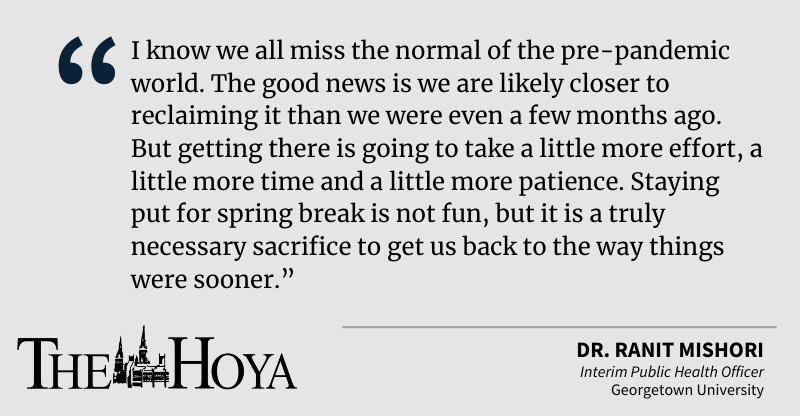It has been a year since you all got the email that informed you Georgetown University would switch to virtual learning until further notice.
Although we could not have known it at the time, for many of you, departing for spring break 2020 was only the beginning of a much longer departure from campus. The past year was one in which everything changed: how we study, how we gather, how we interact with each other and what we do to protect ourselves and others.
This year’s spring break is just days away. The weather improves with each day, the annual cherry blossom season is approaching and there is hope on the horizon with the rollout of safe and effective vaccines.
But much to everybody’s frustration, the COVID-19 pandemic continues to rage across the country and in the Washington, D.C. area. What does that mean for spring break? It is not the news any of us wanted — public health conditions, once again, demand we avoid travel.
We are at a critical juncture in our local and national response to COVID-19 as we race to vaccinate faster than new variants can spread. According to the Centers for Disease Control, these new variants spread more easily and quickly than other variants; a few of them appear to be more deadly. Their rapid spread may strain our health care resources and increase hospitalizations and deaths.
Travel by plane, train or bus increases the risk of prolonged close contact with other travelers who may be infected. If you must travel, it is safest by private car and with only members of your immediate household.
If you plan to vacation at a beach resort, know, figuratively, traveling to these places is like approaching the eye of the storm. Not only does flying there increase your risk of infection, but once you arrive, you will likely find yourself in and around crowds, unable to tell who has the coronavirus or one of its more contagious variants.
Already, as visitors have begun flocking to Florida, Miami Beach declared a state of emergency, enforcing a curfew on outdoor dining, shutting down traffic and banning strolling at night because of a fear of a resurgence in COVID-19 cases.
If you do travel, it is critical you self-quarantine as soon as you return and schedule a COVID-19 test three to five days after returning. It can be challenging, but you should continue to self-quarantine until you receive a negative result, as this time period poses the greatest risk of community transmission.
Social gatherings with people outside individuals’ households during quarantine periods — even in small groups — were a primary driver of our COVID-19 outbreaks following winter break, which led to a pause of in-person hybrid classes and on-campus activities.
If you are a student with campus eligibility, please inform us of your travel plans in the GU360 Daily Check-In so we can provide COVID-19 resources and the necessary quarantine services when you return to campus.
I understand you all know this information, but it bears repeating that opportunities to unplug and unwind while minimizing the risk to yourself and others exist. Since COVID-19 spreads less easily outdoors than indoors, outdoor-oriented experiences, like camping or hiking, prove much safer than spending time at hotels or resorts. Additionally, whenever you are in the company of people outside your own household, it is safest to remain outdoors while still wearing a mask and maintaining at least six feet of distance.
As many of you begin to receive the vaccines, remember being fully vaccinated — two weeks after your second dose of the Moderna of Pfizer vaccine or the administration of the Johnson & Johnson vaccine — does not mean life is back to pre-COVID-19, normal days. Current data has not yet made clear whether the vaccines are effective in preventing transmission of the virus from a vaccinated person to an unvaccinated person or if they are as effective against the new variants.
The CDC recently released encouraging guidance for everyday activities for those who are fully vaccinated, but these activities do not include the mixing of unvaccinated people from multiple households in indoor settings. For example, one family living in the same household visiting their fully vaccinated grandparents and spending time indoors without protective measures is safe, but multiple households with unvaccinated members gathering for an Easter celebration is not.
I know we all miss the normal of the pre-pandemic world. The good news is we are likely closer to reclaiming it than we were even a few months ago. But getting there is going to take a little more effort, a little more time and a little more patience.
Staying put for spring break is not fun, but it is a truly necessary sacrifice to get us back to the way things were sooner.
Dr. Ranit Mishori is Georgetown University’s interim chief public health officer and a professor of family medicine at the Georgetown University School of Medicine and a graduate from the Georgetown School of Medicine.









